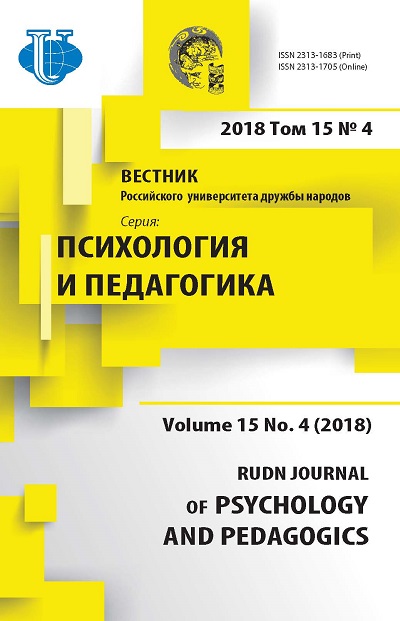Оценка степени аутентичности студенческих академических текстов на иностранном языке
- Авторы: Чуйкова Э.С.1
-
Учреждения:
- Самарский филиал Московского городского педагогического университета
- Выпуск: Том 15, № 4 (2018)
- Страницы: 500-511
- Раздел: ПСИХОЛОГО-ПЕДАГОГИЧЕСКИЕ ПРОБЛЕМЫ ВЫСШЕГО ОБРАЗОВАНИЯ
- URL: https://journals.rudn.ru/psychology-pedagogics/article/view/20377
- DOI: https://doi.org/10.22363/2313-1683-2018-15-4-500-511
Цитировать
Полный текст
Аннотация
Необходимость достойного представления отечественной науки в мировом научном пространстве вызвала пристальный интерес исследователей различных областей к вопросам обучения академическому письму на английском языке в российских вузах. Интегративный характер дисциплины позволяет рассматривать вопросы развития академической грамотности как общеметодологические, без акцента на предметную область. Среди актуальных вопросов обучения академическому письму выделяется недостаточно исследованная проблема оценивания качества результатов обучения - текстов. Традиционные критерии оценивания - структура, содержание и языковая грамотность - позволяют детально оценить различные стороны текста. Однако такая модель не носит интегративного характера. Для пишущего целостное понимание сущности академического появляется с введением понятия «аутентичность текста». Категория «аутентичность академического текста» позволяет объединить разрозненные критерии, т.к. идейно объясняет, как стремление к созданию аутентичного текста на иностранном языке одновременно реализуется во всех трех аспектах: структурно, в содержании и языковом воплощении. В статье представлены понимание категории аутентичности и модель ее измерения, апробированная в курсе обучения академическому письму на английском языке в российском вузе. Описанная система оценивания может быть использована для повышения качества профессиональной языковой подготовки студентов и магистрантов, нацеленных на публикацию результатов исследовательской деятельности.
Об авторах
Элина Сергеевна Чуйкова
Самарский филиал Московского городского педагогического университета
Email: chuikova_elina@mail.ru
кандидат педагогических наук, доцент Самарского филиала Московского городского педагогического университета Российская Федерация, 443081, Самара, Стара Загора ул., 76
Список литературы
- Akerblom, D., & Lindahl, M. (2017). Authenticity and the relevance of discourse and figured worlds in secondary students’ discussions of socioscientific issues. Teaching and Teacher Education, 65, 205-214. doi: 10.1016/j.tate.2017.03.025
- Akester, P. (2004). Authorship and authenticity in cyberspace. Computer Law & Security Review, 20(6), 436-444. doi: 10.1016/S0267-3649(04)00088-3
- Bazanova, E.M., & Sokolova, E.E. (2017). Massive Open Online Course on Academic Writing: Management of Students’ Motivation to Study. Vysshee obrazovanie v Rossii, 2(209), 99-109. (In Russ.)
- Behizadeh, N., & Engelhard, Jr. G. (2014). Development and validation of a scale to measure perceived authenticity in writing, Assessing Writing, 21, 18-36. doi: 10.1016/j.asw.2014.02.001
- Behizadeh, N., & Engelhard, G. (2016). Examining the Psychometric Quality of a Modified Perceived Authenticity in Writing Scale with Rasch Measurement Theory. In Zhang, Q. (Ed.). Pacific Rim Objective Measurement Symposium (PROMS) 2015. Conference Proceedings. Singapore: Springer. doi: 10.1007/978-981-10-1687-5_5
- Bogolepova, S.V. (2016). Teaching Academic Writing: Process and Product. Vysshee obrazovanie v Rossii, 1(197), 87-94. (In Russ.)
- Chuikova, E. (2017). Introducing cross cultural perspectives into teaching academic writing to Master’s students in Russia. Modern Journal of Language teaching Methods (MJLTM), 7(8), 228-239.
- Ciornei S. I., & Dina, T.A. (2015). Authentic Texts in Teaching English. Procedia - Social and Behavioral Sciences, 180, 274-279. doi: 10.1016/j.sbspro.2015.02.116
- Connor, U. (2008). Contrastive Rhetoric: Reaching to Intercultural Rhetoric. Amsterdam; Philadelphia: John Benjamins Publishing Company. 324 p.
- Fox, C. (1997). The authenticity of intercultural communication. International Journal of Intercultural Relations, 21(1), 85-103. doi: 10.1016/S0147-1767(96)00012-0
- Frumina, E. (2018). Internationalization of Higher Education in Russia: English Language Teaching Landscape. HERB English in Russian Universities: Mind the Gap, 2(16), 14-16.
- Gebhard, M., Demers, J., & Castillo-Rosenthal, Z. (2008). Teachers as critical text analysts: L2 literacies and teachers’ work in the context of high-stakes school reform. Journal of Second Language Writing, 17(4), 274-291. doi: 10.1016/j.jslw.2008.05.001
- Guzikova, M., & Akoev, M. (2018). Increasing Research Impact by Developing Research Communication Skills. HERB English in Russian Universities: Mind the Gap, 2(16), 10-11.
- Hirvela, A., Hyland, K. & Manchón, R.M. (2016). Dimensions in L2 writing theory and research: Learning to write and writing to learn. In Manchón, R. & Matsuda, P.K. (Eds.). Handbook of second and foreign language writing (pp. 45-64). Berlin: De Gruyter.
- Korotkina, I.B. (2018). Russian Scholarly Publications in Anglophone Academic Discourse: The Clash of Tyrannosaurs. Integration of Education, 22(2), 311-323. doi: 10.15507/1991-9468.091.022.201802 (In Russ.)
- Kostrova, O., & Kulinich, M. (2015). Text Genre ‘Academic Writing’: Intercultural View. Procedia - Social and Behavioral Sciences, 206, 85-89. doi: .org/10.1016/j.sbspro.2015.10.032
- McCulloch, S. (2013). Investigating the reading-to-write processes and source use of L2 postgraduate students in real-life academic tasks: An exploratory study. Journal of English for Academic Purposes, 12(2), 136-147. doi: 10.1016/j.jeap.2012.11.009
- Nicaise, M., Gibney, T., & Crane, M. (2000). Toward an understanding of authentic learning: Student perceptions of an authentic classroom. Journal of Science Education and Technology, 9, 79-94.
- Voevoda, E.V. (2018). Teaching Research Methodology - Theory, Methods, Practice: The Case for English Language Master Programme. RUDN Journal of Psychology and Pedagogics, 15(2), 209- 221. doi: 10.22363/2313-1683-2018-15-2-209-221 (In Russ.)
- Weigle, S.C., & Parker, K. (2012). Source text borrowing in an integrated reading/writing assessment.Journal of Second Language Writing, 21(2), 118-133. doi: 10.1016/j.jslw.2012.03.004
- Winn, M.T., & Johnson, L. (2011). Writing instruction in the culturally relevant classroom. Urbana, IL: National Council of Teachers of English. 101 p.















